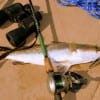 By Ed Snyder/Outdoors
By Ed Snyder/Outdoors
East Bay, at Gilchrist on Bolivar, TX.
As warm breezes puffed my boat began swaying slowly like a child’s cradle causing me to doze off for a spell. Suddenly, high pitched screeching sounds snapped me out of a potential siesta. These sounds were of excited seagulls on a feeding spree not far off!
Cranking up and throttling out from a grassy cove I had settled into in hopes of catching a flounder, or two, soon had me changing my interests from flounder to looking for flocks of seagulls. I Spotted them dipping and diving in a tight circle not 200 yards away. My adrenaline maxed as I throttled towards this frenzied fracas!

FIRST CAST
Some of this seasons most exciting fishing action is about to happen on the Galveston Bay System, especially on East Bay near Rollover Pass. In fact, it’s happening right now as of this writing. It’s called “working the birds!”
Every Fall when the air temps start to dip, cooling the water, bait fish and shrimp begin moving from the chilling bays to the warmer waters of Gulf of Mexico. This massive movement attracts huge schools of predator fish such as speckled trout and red fish who feed on them. These feeding sprees in turn attracts flocks of seagulls, who in turn feed on the panicked, fleeing bait.

Seabird feeding frenzy
After getting within 50 yards of this activity, I throttled down, shutting off the outboard and set my electric troll-motor overboard. Silently moving in I saw two other boats had arrived and were already hooking up, so I moved away from them to avoid spooking their action, pointing my bow towards another flock of birds not much farther out. The water was popping as the trout were hungrily snatching skittering shrimp from the surface.
Moving within casting distance and lobbing a silver spoon into the melee quickly awarded me with my first hook-up! Within a few short moments a silvery spotted speckled sea trout, came aboard. Another cast, another hit, and another sea-trout. Another cast, another hit, and another sea trout. And so it went for about 15 minutes as hit after hit produced trout after trout until I had my 10 speck limit in the box.
The bait soon scattered, the trout moved off, and the birds disappeared. My fifteen minutes of excitement had been a plus. I’ve witnessed birds up and working for an hour or better, but for the most part the “bird” action won’t last but a few minutes at most. It really depends on the amount of bait that’s schooled in the area. In one incredible feeding spree I enjoyed with friends a couple of years ago the feeding spree lasted more that two hours and the fish weren’t trout but red fish. That was a very memorable fishing trip that landed us a nine red fish limit weighing over 70lbs.
Peak times for chasing the birds is from October thru December from daybreak till 10am in the morning then again around 2pm to 4pm in the afternoon. I fish ¾ oz silver or gold spoons due to being able to cast good distances and they work very well. But top-water, and subsurface hard plastics will produce as will soft plastics and speck-rigs. Even fly rod anglers fishing streamers can take advantage of this sport as do kayakers and canoeists.

Kayaker's take advantage of Autumns birding activity.
But boaters with high tech outboards and electric troll-motors will always have the upper hand due to the fact that they are more maneuverable and are quicker getting to them. But if I had my druthers kayaks would be my choice putting you up front and personal with the fish.
Always keep a pair of binoculars in the boat for spotting working birds off in the distance. A good fishing map with recorded structure and GPS points is also a plus to have on board for locating prime fishing sites. It’s also important to note that seagulls, not terns, will put you on fish. Terns are terrible fish spotters and are often referred to as liar birds. Seagulls, however are 100% on when spotting feeding fish. Make sure they are hovering low and diving in a feeding area. If they’re high and swooping they aren’t on fish as yet.
One thing to remember though, when moving on a school of feeding trout under birds shut your engine down about 50 to 100 yards upwind, then drift in to the action to avoid spooking the fish. If you’re rigged with a trolling motor use the TM to take you within casting distance (about 30 yards). NEVER move on top of the feeding fish or you will most certainly spook them. If other boaters are already there keep a good distance away from them to avoid ruining their fishing day. It’s a common sense factor here folks.

THUMBS UP for the bird action putting these trout in the box.
“Chasing the birds” is a must do for your bucket list of things to experience and enjoy in your life and can instill fond memories of some exciting fishing times experienced.
My hopeful flounder fishing trip had turned out to be very successful, but for trout rather than flounder. But for now the flounder would have to wait as ten speckled sea-trout laid on ice in my cooler to be cleaned and prepared for many suppers yet to come. It’s prime time bird chasing on the bay folks………………………GO GETTUM!!
This article sponsored by Miss Nancy’s Bait Camp.

 Posted in
Posted in 























